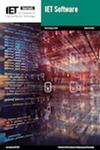Comparing Measured Agile Software Development Metrics Using an Agile Model-Based Software Engineering Approach versus Scrum Only
IF 1.3
4区 计算机科学
Q3 COMPUTER SCIENCE, SOFTWARE ENGINEERING
引用次数: 0
Abstract
This study compares the reliability of estimation, productivity, and defect rate metrics for sprints driven by a specific instance of the agile approach (i.e., scrum) and an agile model-Bbased software engineering (MBSE) approach called the integrated Scrum Model-Based System Architecture Process (sMBSAP) when developing a software system. The quasi-experimental study conducted ten sprints using each approach. The approaches were then evaluated based on their effectiveness in helping the product development team estimate the backlog items that they could build during a time-boxed sprint and deliver more product backlog items (PBI) with fewer defects. The commitment reliability (CR) was calculated to compare the reliability of estimation with a measured average scrum-driven value of 0.81 versus a statistically different average sMBSAP-driven value of 0.94. Similarly, the average sprint velocity (SV) for the scrum-driven sprints was 26.8 versus 31.8 for the MBSAP-driven sprints. The average defect density (DD) for the scrum-driven sprints was 0.91, while that of the sMBSAP-driven sprints was 0.63. The average defect leakage (DL) for the scrum-driven sprints was 0.20, while that of the sMBSAP-driven sprints was 0.15. The t-test analysis concluded that the sMBSAP-driven sprints were associated with a statistically significant larger mean CR, SV, DD, and DL than that of the scrum-driven sprints. The overall results demonstrate formal quantitative benefits of an agile MBSE approach compared to an agile alone, thereby strengthening the case for considering agile MBSE methods within the software development community. Future work might include comparing agile and agile MBSE methods using alternative research designs and further software development objectives, techniques, and metrics.比较使用基于敏捷模型的软件工程方法与仅使用Scrum的度量敏捷软件开发指标
本研究在开发软件系统时,比较了由敏捷方法(即scrum)的特定实例和敏捷基于模型的软件工程(MBSE)方法(称为集成的scrum基于模型的系统架构过程(sMBSAP))驱动的sprint的评估可靠性、生产力和缺陷率指标。准实验研究使用每种方法进行了10次冲刺。然后根据这些方法在帮助产品开发团队评估他们可以在时间限定的冲刺期间构建的待办事项项以及交付更多具有更少缺陷的产品待办事项项(PBI)方面的有效性来评估这些方法。通过计算承诺信度(CR)来比较估算信度与测量的平均scrum驱动值(0.81)和统计上不同的平均smbsap驱动值(0.94)。类似地,scrum驱动的sprint的平均冲刺速度(SV)是26.8,而mbsap驱动的sprint是31.8。scrum驱动的sprint的平均缺陷密度(DD)是0.91,而smbsap驱动的sprint的平均缺陷密度是0.63。scrum驱动的sprint的平均缺陷泄漏(DL)是0.20,而smbsap驱动的sprint的平均缺陷泄漏(DL)是0.15。t检验分析得出结论,smbsap驱动的sprint与统计上显著大于scrum驱动的sprint的平均CR、SV、DD和DL相关。总体结果证明了与单独的敏捷方法相比,敏捷MBSE方法的正式量化好处,从而加强了在软件开发社区中考虑敏捷MBSE方法的案例。未来的工作可能包括使用替代研究设计和进一步的软件开发目标、技术和度量来比较敏捷和敏捷MBSE方法。
本文章由计算机程序翻译,如有差异,请以英文原文为准。
求助全文
约1分钟内获得全文
求助全文
来源期刊

IET Software
工程技术-计算机:软件工程
CiteScore
4.20
自引率
0.00%
发文量
27
审稿时长
9 months
期刊介绍:
IET Software publishes papers on all aspects of the software lifecycle, including design, development, implementation and maintenance. The focus of the journal is on the methods used to develop and maintain software, and their practical application.
Authors are especially encouraged to submit papers on the following topics, although papers on all aspects of software engineering are welcome:
Software and systems requirements engineering
Formal methods, design methods, practice and experience
Software architecture, aspect and object orientation, reuse and re-engineering
Testing, verification and validation techniques
Software dependability and measurement
Human systems engineering and human-computer interaction
Knowledge engineering; expert and knowledge-based systems, intelligent agents
Information systems engineering
Application of software engineering in industry and commerce
Software engineering technology transfer
Management of software development
Theoretical aspects of software development
Machine learning
Big data and big code
Cloud computing
Current Special Issue. Call for papers:
Knowledge Discovery for Software Development - https://digital-library.theiet.org/files/IET_SEN_CFP_KDSD.pdf
Big Data Analytics for Sustainable Software Development - https://digital-library.theiet.org/files/IET_SEN_CFP_BDASSD.pdf
 求助内容:
求助内容: 应助结果提醒方式:
应助结果提醒方式:


